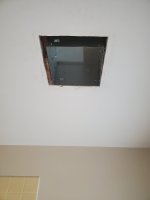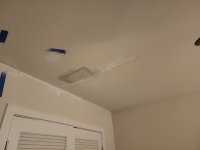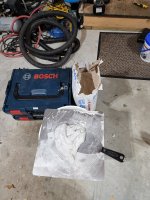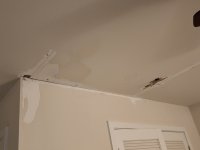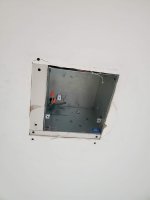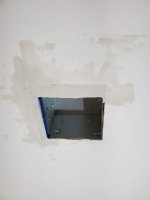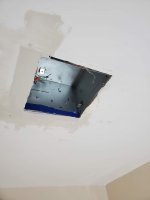squall_line
Member
Long story short, I'm replacing the vent fan in our bathroom after the new bath and shower were put in.
The new fan box is about 2" shorter in one dimension and 1" shorter in the other dimension, leaving an L-shaped gap around the fan. I dry-fitted the plate and it definitely doesn't cover the opening, besides all of the cold air spilling down from the attic.
[attachimg=1]
My current plan is to buy a 24"x24" drywall "patch" and cut it to shape/size (maybe slightly under-sized). Then screw two pieces of lath/strapping/furring strips inside the attic but through the ceiling as a backer that I can screw the drywall patch to, and then mesh tape and mud the whole kit-n-kaboodle (this is how those "This Old House" guys showed it for square openings, at least).
My main concern is that the current ceiling is 3/8" drywall, wire mesh lath, then 3/8" plaster, for a total thickness ranging from 3/4"-7/8". I don't know if I need to get 1/2" and 1/4" drywall both, to compensate, or if I should use furring strips to compensate, or what. I definitely don't want to build up 1/8"-1/4" of joint compound just to make up the thickness.
Thoughts?
The new fan box is about 2" shorter in one dimension and 1" shorter in the other dimension, leaving an L-shaped gap around the fan. I dry-fitted the plate and it definitely doesn't cover the opening, besides all of the cold air spilling down from the attic.
[attachimg=1]
My current plan is to buy a 24"x24" drywall "patch" and cut it to shape/size (maybe slightly under-sized). Then screw two pieces of lath/strapping/furring strips inside the attic but through the ceiling as a backer that I can screw the drywall patch to, and then mesh tape and mud the whole kit-n-kaboodle (this is how those "This Old House" guys showed it for square openings, at least).
My main concern is that the current ceiling is 3/8" drywall, wire mesh lath, then 3/8" plaster, for a total thickness ranging from 3/4"-7/8". I don't know if I need to get 1/2" and 1/4" drywall both, to compensate, or if I should use furring strips to compensate, or what. I definitely don't want to build up 1/8"-1/4" of joint compound just to make up the thickness.
Thoughts?

